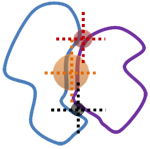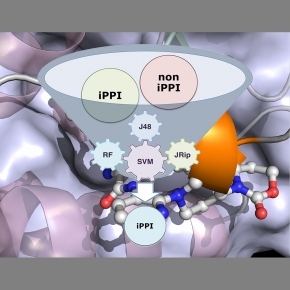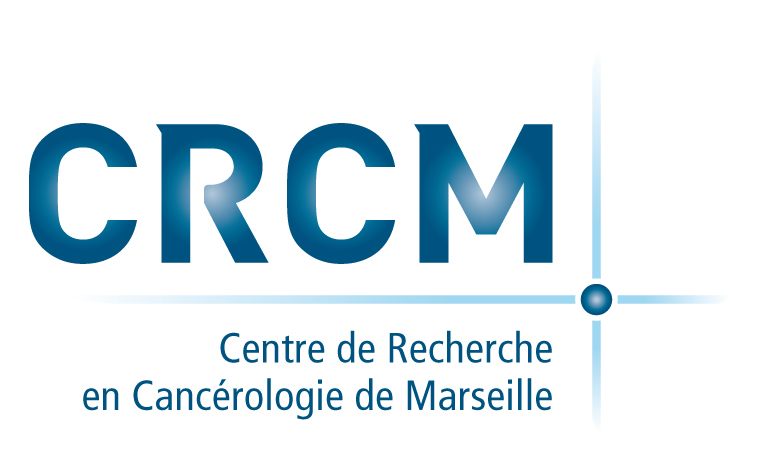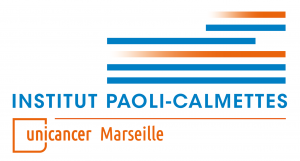Overview
In the very recent years the number of small molecule disrupting protein-protein interactions (PPIs) has grown rapidly partly due to the improvement of in silico drug discovery methods. PPIs are now considered as the next generation of very promising therapeutic targets (Roche & Morelli, 2010).
Although a lot of PPI inhibitors have been discovered, little is known about structural parameters that govern the druggability of protein-protein interactions and about the chemical properties of small molecule inhibitors of PPI. We have analyzed the interface of PPI for which both the protein-protein and protein-inhibitor complexes have been structurally characterized to extract the best descriptors of PPI with a known inhibitor.
The chemical space of PPI is not completely covered due to the limited amount of data currently available; however, the definition of what makes a PPI a potentially druggable target will become more and more reliable, as the number of 3D structures increases.
2P2I Database
Structural Database of Protein-Protein Complexes and their Inhibitors
![]()
![]() 2P2IDB is a hand-curated database dedicated to the structure of protein-protein complexes with known small molecule inhibitors. We have gathered from the PDB, PPIs and orthosteric small molecule inhibitors found at the interface . Interfaces in 2P2IDB have been analyzed in terms of geometrical parameters, atom and residue properties, buried accessible surface area and other biophysical parameters and compared to those of representative datasets of heterodimeric complexes. The PPI complexes have been classified into 3 classes based on the number of segments at the interface and target properties (Basse et al, 2016; Basse et al, 2013).
2P2IDB is a hand-curated database dedicated to the structure of protein-protein complexes with known small molecule inhibitors. We have gathered from the PDB, PPIs and orthosteric small molecule inhibitors found at the interface . Interfaces in 2P2IDB have been analyzed in terms of geometrical parameters, atom and residue properties, buried accessible surface area and other biophysical parameters and compared to those of representative datasets of heterodimeric complexes. The PPI complexes have been classified into 3 classes based on the number of segments at the interface and target properties (Basse et al, 2016; Basse et al, 2013).
2P2I inspector
 Protein-protein interface analysis tool
Protein-protein interface analysis tool
2P2IINSPECTOR is a tool to calculate a series of physical and chemical descriptors that characterize protein-protein and protein-ligand interfaces from 3D structures ( Basse et al, 2016; Basse et al, 2013 ). These 51 parameters include interface area, gap volume, eccentricity, circularity, planarity, non-bonded contacts, hydrogen-bonds, residue and atomic composition, number of segments and secondary structure contribution. Users can analyze protein complexes from the PDB using standard four letter accession codes or upload their own PDB files. The analyzed complex can be visualized using a Jmol applet containing a user-friendly menu. This new tool thus provides an efficient way of characterizing protein-protein and protein-ligand interfaces.
Fr-PPIChem : PPI-oriented Chemical Library
 Design of Focussed PPI Chemical Libraries
Design of Focussed PPI Chemical Libraries
Fr-PPIChem is a chemical library of 10,314 molecules dedicated to the inhibition of protein-protein interactions (Bosc et al, 2020). These compounds are plated in a standardized form compatible with high or medium throughput screening. It was built using a combination of learning approaches (SVM) and general profiles of PPI inhibitors derived from the set of orthosteric PPI inhibitors present in the 2P2I database (Morelli et al, 2011).
 References
References
- - Basse MJ, Betzi S, Morelli X, Roche P: 2P2Idb v2: Update of a Structural Database Dedicated to Orthosteric Modulation of Protein-Protein Interactions. Database Update 2016; DOI: 10.1093/database/baw007
- - Basse MJ, Betzi S, Bourgeas R, Bouzidi S, Chetrit B, Hamon V, Morelli X, Roche P: 2P2Idb: A Structural Database Dedicated to Orthosteric Modulation of Protein-Protein Interactions. Nucleic Acid Research 2013; 41:D824-827. Pubmed ID: 23203891
- - Roche P, Morelli X: Protein-Protein Interaction Inhibition (2P2I): Mixed Methodologies for the Acceleration of Lead Discovery. in In silico lead discovery. Edited by Miteva M: Bentham; 2010:118-143.
- - Bourgeas R, Basse M-J, Morelli X, Roche P: Atomic Analysis of Protein-Protein Interfaces with Known Inhibitors: The 2P2I Database. PLoS ONE 2010, 5:e9598. Pubmed ID: 20231898
- - Morelli X, Bourgeas R, Roche P: Chemical and structural lessons from recent successes in protein-protein interaction inhibition (2P2I). Curr Opin Chem Biol 2011, 15:475-481. Pubmed ID: 21684802










